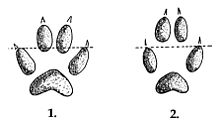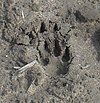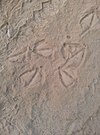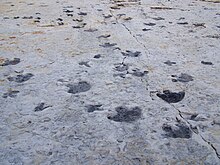Step seal
A step seal is the imprint of the extremity of a vertebrate animal in soft ground. They may be, depending on the anatomy of the limb to the impression of a complete foot (at sole goers s part), or only the front (st) of the foot (in the toe and top goers ) act. With the help of step seals, the animal species can be determined in the most favorable case, and also the time at which the animal walked there using the status of the step seal.
In the hunting language , Trittsiegel is the technical term for an imprint of the extremities (legs) of various types of game , especially that of the hoofed game . Several footprints behind one another produce a track , whereby such term applies in the Jägersprache especially for ungulates (for other types of game corresponding track or turf ). In general terms, a footprint is also called a footprint , especially when it is an imprint of a human foot . In general terms, both individual footprints and tracks are referred to as footprints .
Fossil footsteps are the subject of research in the field of palichnology .
Distinguishing features
Step seals reflect the anatomy of the feet of their creators in the loaded state. Each track can be assigned to a specific species. For example, footsteps from ungulates differ significantly from z. As those of predatory mammals by most ungulates to the top goers are only one or two dominant toes footprints left while in mammalian predators, most of which his toes , usually four toes and a are bales are footprints. Within the predatory mammals, a further distinction can be made whether there are claws or the position of the toes in relation to each other and to the ball of the foot.
The imprint results from the interaction of weight per area and the type of subsoil (also called substrate , e.g. earth , pure sand , snow ). The softer the substrate, the deeper the impression, the finer-grained the substrate, the clearer and sharply defined the impression. An imprint changes depending on the environmental conditions (e.g. precipitation and temperature). Only under favorable conditions can the tread seals be retained for a long time.
With a plaster cast , a step seal can be depicted and preserved in three dimensions.
Selection of step seals with their characteristics
Notes: In the measurements, the front paw is abbreviated as VP, the rear paw as HP. The length is measured from the tip of the ball of the longest toe to the rear edge of the ball of the sole or heel ball. The width is the widest part of the step seal between the very edges of the ball of the toe.
| animal | schematic | in kind | Features (including dimensions) |
|---|---|---|---|
| Domestic cat (predatory mammal) |  |
in coarse, dry sand |
|
| Eurasian lynx (predatory mammal) | 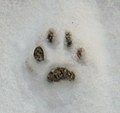 |
|
|
| Domestic dog (predatory mammal) |  |
in moist sandy-loamy silt |
|
| Fox (predatory mammal) | in moist sandy-loamy silt |
|
|
| Badger (predatory mammal) | in mud in snow |
|
|
| Tree marten and stone marten (predatory mammals) | Pine marten trail in the mud |
|
|
| Polecat (predatory mammal) |
|
||
| Ermine and weasel (predatory mammals) |
|
||
| Lynx (predatory mammal) |
|
||
| Wolf (predatory mammal) |  |
in dried clayey substrate |
|
| Brown bear (predatory mammal) | VP in moist soil |
|
|
| Otter (predatory mammal) |
|
||
| beaver |
|
||
| Nutria |
|
||
| muskrat |
|
||
| racoon | in soil |
|
|
| Raccoon dog |
|
||
| squirrel |
|
||
| Hedgehog | in soil |
|
|
| Brown hare | in snow |
|
|
| Wild rabbit |
|
||
| Wild boar (cloven) | ↔ in the ground |
|
|
| Roe deer (cloven-hoofed) |  |
in snow |
|
| Red deer (cloven) | in snow |
|
|
| Fallow deer (cloven) |
|
||
| Muffelwild (cloven) |
|
||
| Chamois ( even-toed ungulate) |
|
||
| Mallard |  |
in the ground |
|
| Mute swan |
|
||
| Greylag goose | in the ground | ||
| Gray heron | in the pond floor |
|
Petrified footsteps
On layers of sediments deposited on the mainland, or rather on the sedimentary rocks that emerged from them, step seals from past geological ages can be passed down from extinct animals (e.g. dinosaurs ). Such fossil footsteps fall under the generic term trace fossils (see also → tracking sandstone ).
literature
- Ilse Haseder , Gerhard Stinglwagner : Knaur's large hunting dictionary . Augsburg 2000, ISBN 3-8289-1579-5 .
Web links
- www.spurenjagd.de
- https://www.jagdverband.de/sites/default/files/Faehrten-und-Spuren_2015_RZ-vs.pdf
- http://www.loutres.be/IMG/pdf/Spurensucherschulung.pdf
Individual evidence
- ↑ Ilse Haseder, p. 796
- ↑ Luchs Bayern EV: Tracking
- ↑ http://www.dassenwerkgroepbrabant.nl/deutsch/trittsiegel_dachs.html
- ↑ Archived copy ( memento of the original from March 29, 2012 in the Internet Archive ) Info: The archive link was inserted automatically and has not yet been checked. Please check the original and archive link according to the instructions and then remove this notice.
- ↑ www.wolf-mv.de Who was it? Recognize and document traces and cracks of large predators page 13
- ↑ https://chwolf.org/woelfe-kennenlernen/monitoring/spurenbeobachtung
- ↑ http://www.kora.ch/index.php?id=153
- ↑ http://wildtiere-stadt.wildtiere-bw.de/schaeden/garten/trittsiegel_faehrten/igel.html
- ↑ http://wildtiere-stadt.wildtiere-bw.de/schaeden/garten/trittsiegel_faehrten/wildkaninchen_feldhase.html
- ↑ http://wildtiere-stadt.wildtiere-bw.de/schaeden/garten/trittsiegel_faehrten/wildkaninchen_feldhase.html
- ↑ http://wurzeltrapp.de/wildtiere/das-wildschwein-wildtiere-und-faehrtenkunde/
- ↑ https://diejagd.com/26-fauna/saeugetiere/paarhufer/82-damwild-dama-dama
- ↑ http://wildeswissen.de/2017/03/17/tiersteckbrief-das-muffelwild/
- ↑ http://www.digitalefolien.de/biologie/gs/tiere/113gaems.html
